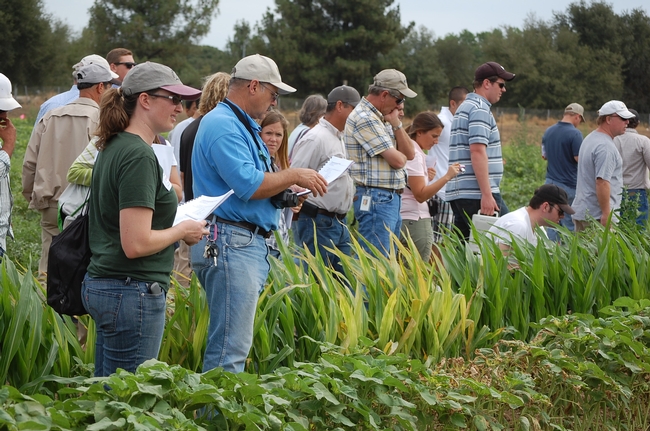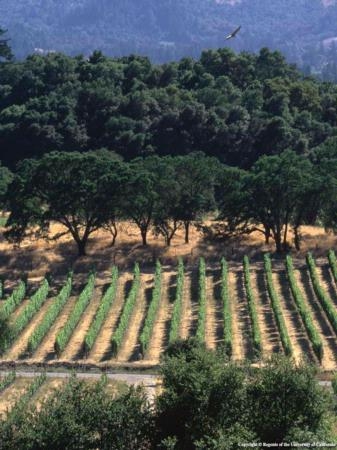Posts Tagged: John Roncoroni
Root out weed problems with upcoming courses at UC Davis
Weeds are a pervasive and expensive problem in California. They can choke waterways, crowd out native species on rangeland, and rob farmers of crop yields. According to the California Invasive Plant Council, the annual cost of invasive plant work in California is at least $82 million.
The University of California has robust educational resources to help those engaged in the battle, and this summer UC Davis and UC Agriculture and Natural Resources personnel are offering a trio of programs to help in the effort.
Weed Day: July 7, 2016
The 60th annual Weed Day will be held at UC Davis on July 7 from 8 a.m. to 4:30 p.m. The program gets under way in the Buehler Alumni Center.
Weed Day will be of interest to pest control advisers, chemical company cooperators, faculty, students and regulatory officials. It is an opportunity to learn about the latest research and to visit current weed-control field trials. The event begins with a bus tour to the research plots. Following lunch, staff and students will present information on projects that are either not in-season or located too far off campus for viewing.
“We have tomatoes, walnuts, and almonds, as well as aquatic research results, and a weed identification quiz,” said professor and UC Cooperative Extension specialist Kassim Al-Khatib, chair of this year's event. “We'll be hearing about control of medusahead, management in grapes, a new herbicide for rice, and many studies on herbicide resistance issues.”
For additional information and to register.
Diagnosing Herbicide Symptoms: July 8, 2016
The Weed Research and Information Center at UC Davis is offering a new course, Diagnosing Herbicide Symptoms, on July 8 at the Bowley Plant Science Teaching Center.
This program will be of interest to pest control advisers, chemical companies, field investigators and insurance adjusters. The course focuses on how an herbicide injury situation can arise, what information can help diagnose herbicide problems during field investigations, and what tools are available.
Topics include herbicide modes of action, symptom development, recovery from herbicide injury, economic damage, and other areas. Instruction takes place in a lecture, field visit, and hands-on demonstrations. Course instructors include UC Cooperative Extension (UCCE) specialists Kassim Al-Khatib and Brad Hanson, UCCE farm advisor John Roncoroni, and Napa County Agricultural Commissioner Greg Clark.
For additional information and to register.
Aquatic Weed School: Sept. 7–8, 2016
The Aquatic Weed School will be held Sept. 7–8 at the Bowley Plant Science Teaching Center.
This intensive course is designed for those involved in consulting, research and management of aquatic weed systems throughout the western United States. Topics include ecological classification and impacts of aquatic weeds, biology of aquatic weeds, physical and chemical characteristics of aquatic ecosystems, regulatory issues, developing an aquatic management plan, aquatic weed identification, equipment demonstration, adjuvants and surfactants for aquatic systems, pest prevention for aquatic weeds, physical and mechanical control methods, biological control, chemical and non-chemical control, and a case study of a complex management plan.
For additional information and to register.
Need more information? Contact Gale Pérez with the UC Weed Research and Information Center, (530) 752-1748, gperez@ucdavis.edu.
Unwelcome weed 'stinkwort' spreading quickly in California
Stinkwort made its first California appearance in 1994, but remained quite rare until the mid-2000s, when it began spreading rapidly. Stinkwort is now found in 36 of the state's 58 counties, particularly along roadsides.
"If it gets a major foothold and produces millions and millions of seeds, then the seedlings will grow and they can form a carpet," DiTomaso said. "Then it would block light and prevent the growth of more desirable species – like native plants. It will out-compete them, and that is a concern."
Another troubling aspect is that the weed has been seen in vineyards, said John Roncoroni, UCCE advisor in Napa County, a weed science expert.
"I've seen it on the roadsides in Napa, and it's just encroaching into the vineyards at Napa Valley College," he said.
Local collaboration is one secret behind excellent Napa Valley wine
One reason the Napa County wine industry is so successful is its commitment to working together, wrote Paul Franson in an op-ed piece that ran in the Napa Valley Register today. Franson credits frequent industry meetings in the area, where a wealth of information on grape growth and wine production are offered.
A recent meeting he cited was a field day last month in which John Roncoroni, UC Cooperative Extension advisor in Napa County, took two groups through the Huichica Creek Demonstration Vineyard in Carneros to teach attendees how to identify weeds that commonly occur in vineyards.
Other local organizations that bring together local grape and wine producers are the Napa County Agricultural Commissioner's office, the Napa Valley Grapegrowers, Napa Sustainable Winegrowing Group and the UC Davis Department of Viticulture and Enology.
"It’s no wonder that Napa Valley growers get the highest prices for their grapes in the state. They learn how to grow the grapes better," Franson wrote.
UCCE helps organic farmers confront weed control challenges
Organic weed control in orchards is far more difficult than conventional weed control, reported the Daily Democrat. The story was written by Bob Johnson for AgAlert.
The most effective organic approach to weed control is a combination of cultural practices and organic herbicides, said John Roncoroni, UC Cooperative Extension advisor in Napa County, at a pear weed control field meeting.
"This is the wood mulch from last year," Roncoroni pointed out at the field day. "As you can see, the grass is growing on the edges, but it's held up pretty well. This is after a year, but it will break down."
Roncoroni is testing the use of spot applications of organic herbicides in combination with mulches.
"Bindweed is pushing through the wood chip mulch," Roncoroni said. "The mulch is a foot deep, but the bindweed rhizomes are six feet deep."
Rachel Elkins, UCCE advisor in Lake and Mendocino counties, also spoke at the field day. She advised cleaning up weeds conventionally and then converting orchard ground management to organic methods.
"You shouldn't have any weeds within two or three feet of young trees," Elkins said. "It's like growing two crops - you need enough water and nitrogen for the trees and the weeds.
Yuba-Sutter almond harvest prices better this year
Ashley Gebb, The Appeal Democrat
The 2012 almond harvest is expected to be smaller than last year for some farmers, but hopes are for higher prices.
"The crop is not all the way in, so this is strictly rumor, but it seems the crop is a little bit off so price seems to be up a bit, which is good for growers," said Franz Niederholzer, UCCE advisor in Yuba and Sutter counties. "I'm not sure where it will work out with increase in price versus loss in income for reduced yield."





